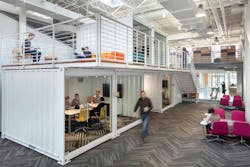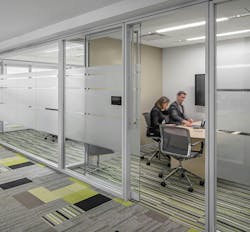For Gen Z, “enhanced communication” won’t cut it
As the fastest-growing generation, Generation Z, loosely defined as those born between the mid-1990s and early 2000s, has become a hot topic in conversations surrounding workplace design. Concerns abound over their reliance on technology and the way post-9/11 culture has influenced their perceptions. Social researchers, marketers, and academics are all looking to find answers to the questions of how to attract, retain, and integrate this talent into an evolving, multi-generational workforce.
Research shows that a Gen Z workplace needs to prioritize technology, promote stability, and increase efficiencies. The fact is, the subtleties in Gen Z’s needs will result in a substantially different office environment. One need look no further than communication, a core concern among managers due to Gen Z's unique exposure to technology.
As a generation with new communication requirements, Gen Z is forcing designers and corporations to re-examine communication's role in the modern office and how it will shape the workplace of the future.
Favoring communication as the key design goal for a Gen Z-friendly workplace makes sense, given their unique struggle with the forms of communication driving business performance – including in-person social contact – and the impact that a four- or five-generation office will have on business operations. Since each generation is communicating in a different way, depending on their exposure to and facility with new technologies, the communication gap between each continues to widen. The more generations in a single company, the more opportunities there are to lose critical knowledge, specifically that which is classified as tacit and best learned through direct interaction. Our goal is to deliver design interventions that can best support corporations as they welcome the newest generation.
Don't Force It
Forcing anything in the workplace, let alone communication, is rarely productive. We need to privilege solutions that accommodate Gen Z’s initial reticence. Rather than develop spaces for forced interactions, we suggest designs that allow for privacy and facilitate less invasive forms of communication. Workstations with low panels allow the Gen Zer to feel safe within his or her space, while simultaneously providing opportunities to make eye contact with fellow workers and managers. They encourage a basic level of communication that can evolve as the employee becomes more comfortable. Similarly, replacing walls with glass panels whenever possible – from private offices to conference rooms – fosters an environment that values both transparency and privacy. The glass walls enable subtle communication and convey a sense of inclusivity.
Get Digital
While Gen Z’s reliance on digital communication – from texting to social media – has arguably limited their in-person communication abilities, ignoring the former’s benefits would be as destructive as eliminating the latter. Instead, digital can be used as a means of promoting interactions between managers and younger staffers. Messaging software – like Jabber, Slack, and Adium – is not always used for formal work-oriented conversations, but is instead valued because it facilitates quick check-ins.
If instant messaging became a formalized part of the work experience, managers and new hires would find themselves conversing on a platform familiar and comforting to Gen Z.
Younger generations are accustomed to talking online, and conversing in this manner can fuel a genuine sense of connectivity between Gen Z and their managers, opening up the door for future in-person communication.
Think Culturally
As they enter the workforce, Gen Z will bring new aspirations for office culture, from a desire to make an impact at the community level to increased emphasis on health and sustainability. Attracting and retaining talents means cultivating a culture that meets these aspirations. And since similar passions and interests often inspire interpersonal relationships, integrating communication into the design strategy can help fulfill these cultural needs. By designing spaces clearly designated for informality, activity, and inclusivity, companies can appeal to the Gen Zer’s cultural values, while creating a foundation for deeper connectivity between multiple generations. One such space might be a zen room with aromatherapy and white noise that creates a stress-relieving environment. Similarly, a designated “active zone,” with yoga mats and foam rollers would promote health and wellness and prompt interaction among people whose roles may not overlap.
The open, active, and comforting characteristics of these spaces will lead to a culture of inclusivity, supporting important Gen Z values such as diversity and equality. Ultimately, these types of spaces reflect a flexible, modern office, and also provide the stability and structure Gen Z seeks.
Summing It Up
Growing technological advancements result in shrinking generations, which means the stressors linked to multi-generational offices will become more pronounced over the coming decades.
The transition from Gen Y to Gen Z marks a critical turning point for considering these stress triggers, and the more generations that enter the workforce, the more critical this conversation will become to optimal workplace design. While the strategies laid out here cater to the unique characteristics of Gen Z, they also address a problem that will only intensify over time.


